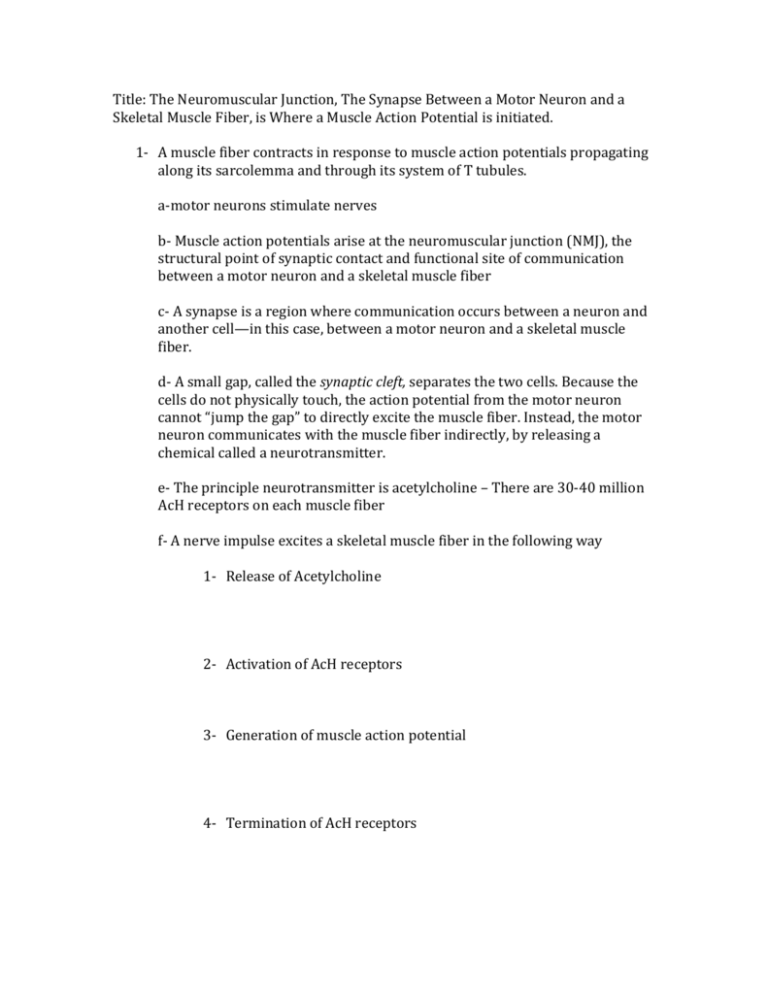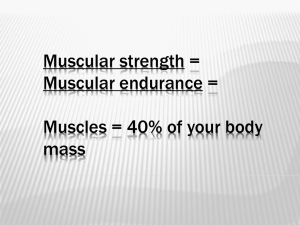Title: The Neuromuscular Junction, The Synapse Between a Motor
advertisement

Title: The Neuromuscular Junction, The Synapse Between a Motor Neuron and a Skeletal Muscle Fiber, is Where a Muscle Action Potential is initiated. 1- A muscle fiber contracts in response to muscle action potentials propagating along its sarcolemma and through its system of T tubules. a-motor neurons stimulate nerves b- Muscle action potentials arise at the neuromuscular junction (NMJ), the structural point of synaptic contact and functional site of communication between a motor neuron and a skeletal muscle fiber c- A synapse is a region where communication occurs between a neuron and another cell—in this case, between a motor neuron and a skeletal muscle fiber. d- A small gap, called the synaptic cleft, separates the two cells. Because the cells do not physically touch, the action potential from the motor neuron cannot “jump the gap” to directly excite the muscle fiber. Instead, the motor neuron communicates with the muscle fiber indirectly, by releasing a chemical called a neurotransmitter. e- The principle neurotransmitter is acetylcholine – There are 30-40 million AcH receptors on each muscle fiber f- A nerve impulse excites a skeletal muscle fiber in the following way 1- Release of Acetylcholine 2- Activation of AcH receptors 3- Generation of muscle action potential 4- Termination of AcH receptors g- Each nerve impulse normally elicits one muscle action potential. If another nerve impulse releases more acetylcholine, then steps 2 and 3 are repeated. h- Because skeletal muscle fibers often are very long cells, the NMJ usually is located near the midpoint of a skeletal muscle fiber. Muscle action potentials arise at the NMJ and then propagate toward both ends of the fiber. This arrangement permits nearly simultaneous activation (and thus contraction) of all parts of the muscle fiber. 2- Excitation–Contraction Coupling a- Excitation–contraction coupling refers to the steps that connect excitation (a muscle action potential propagating along the sarcolemma and into the T tubules) to contraction (sliding of the filaments). 1- 2- 3b- An Action Potential Releases Calcium Ions that Allow the Thick Filaments to Bind to and Pull the Thin Filaments Toward the Center of the Sarcomere. 1- Once an action potential is propagated along the sarcolemma and T tubules, muscle contraction begins. The model describing the contraction of muscle is known as the sliding filament mechanism. 2- Muscle contraction occurs because myosin heads attach to and “walk” along the thin filaments at both ends of a sarcomere, progressively pulling the thin filaments toward the M line 3- the thin filaments slide inward and meet at the center of a sarcomere. They may even move so far inward that their ends overlap 4- As the thin filaments slide inward, the Z discs come closer together, and the sarcomere shortens. Note that the lengths of the individual thick and thin filaments do not change; it is the amount of overlap between them that changes. Shortening of the individual sarcomeres causes shortening of the whole muscle fiber, and ultimately shortening of the entire muscle. 5-








